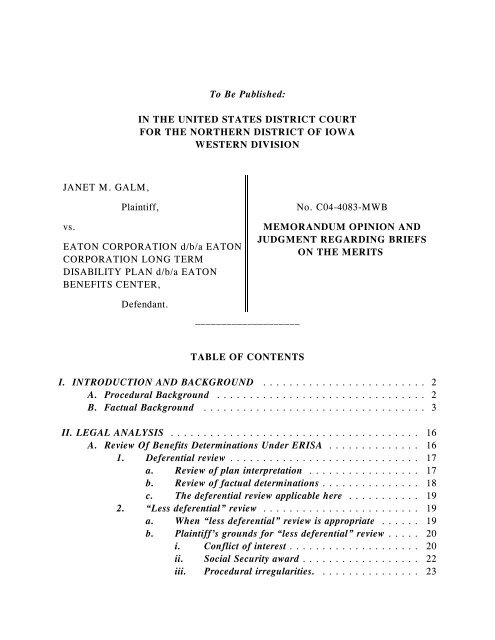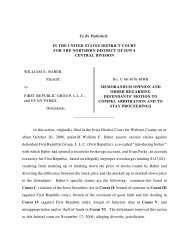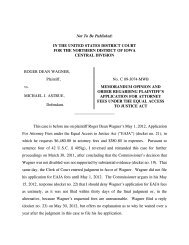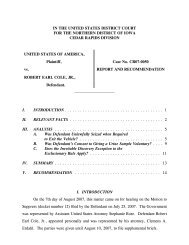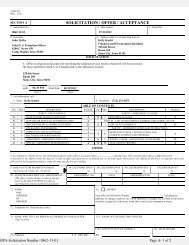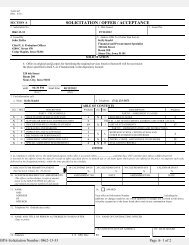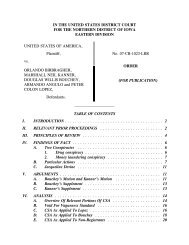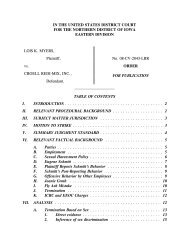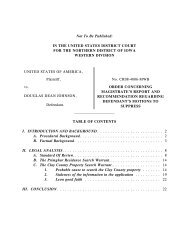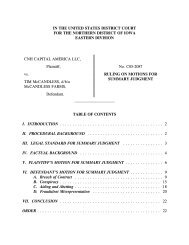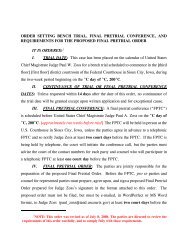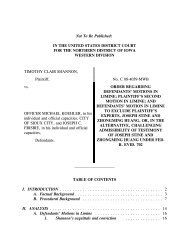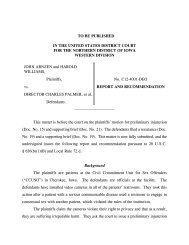Galm v. Eaton Corporation - Northern District of Iowa
Galm v. Eaton Corporation - Northern District of Iowa
Galm v. Eaton Corporation - Northern District of Iowa
Create successful ePaper yourself
Turn your PDF publications into a flip-book with our unique Google optimized e-Paper software.
To Be Published:<br />
IN THE UNITED STATES DISTRICT COURT<br />
FOR THE NORTHERN DISTRICT OF IOWA<br />
WESTERN DIVISION<br />
JANET M. GALM,<br />
vs.<br />
Plaintiff,<br />
EATON CORPORATION d/b/a EATON<br />
CORPORATION LONG TERM<br />
DISABILITY PLAN d/b/a EATON<br />
BENEFITS CENTER,<br />
No. C04-4083-MWB<br />
MEMORANDUM OPINION AND<br />
JUDGMENT REGARDING BRIEFS<br />
ON THE MERITS<br />
Defendant.<br />
____________________<br />
TABLE OF CONTENTS<br />
I. INTRODUCTION AND BACKGROUND ......................... 2<br />
A. Procedural Background ................................ 2<br />
B. Factual Background .................................. 3<br />
II. LEGAL ANALYSIS ...................................... 16<br />
A. Review Of Benefits Determinations Under ERISA .............. 16<br />
1. Deferential review ............................. 17<br />
a. Review <strong>of</strong> plan interpretation ................. 17<br />
b. Review <strong>of</strong> factual determinations ............... 18<br />
c. The deferential review applicable here ........... 19<br />
2. “Less deferential” review ........................ 19<br />
a. When “less deferential” review is appropriate ...... 19<br />
b. Plaintiff’s grounds for “less deferential” review ..... 20<br />
i. Conflict <strong>of</strong> interest .................... 20<br />
ii. Social Security award .................. 22<br />
iii. Procedural irregularities. ............... 23
B. Application Of The Substantial Evidence Test ................. 25<br />
III. CONCLUSION ........................................ 30<br />
I. INTRODUCTION AND BACKGROUND<br />
A. Procedural Background<br />
On August 2, 2004, plaintiff Janet M. <strong>Galm</strong> filed a petition in <strong>Iowa</strong> <strong>District</strong> Court<br />
In And For Clay County against <strong>Eaton</strong> <strong>Corporation</strong> (“<strong>Eaton</strong>”) under the civil enforcement<br />
provision <strong>of</strong> the Employee Retirement Income Security Act <strong>of</strong> 1974 (“ERISA”), 29 U.S.C.<br />
§ 1132(a)(1)(B), seeking long-term disability benefits under an employee welfare benefit<br />
plan (“the Plan”) sponsored by her former employer, <strong>Eaton</strong>. On August 26, 2004,<br />
defendant <strong>Eaton</strong> removed this case to this court pursuant to 28 U.S.C. § 1441(a), alleging<br />
jurisdiction based on ERISA’s express federal jurisdictional provision found in 28 U.S.C.<br />
§ 1332(e).<br />
In <strong>Galm</strong>’s petition, she alleges that <strong>Eaton</strong> denied her second-tier long-term<br />
disability benefits under the Plan, in violation <strong>of</strong> ERISA. In its answer, <strong>Eaton</strong> admits<br />
denying <strong>Galm</strong> second-tier long-term disability benefits, but alleges the denial <strong>of</strong> these<br />
benefits was reasonable and not arbitrary or capricious. Following the court’s granting<br />
plaintiff <strong>Galm</strong>’s request to conduct discovery, see <strong>Galm</strong> v. <strong>Eaton</strong> Corp., 360 F. Supp. 2d<br />
2
978, 984-986 (S.D. <strong>Iowa</strong> 2005), both parties have filed briefs on the merits centered on<br />
the central issue in this case, whether plaintiff <strong>Galm</strong> is disabled under the terms <strong>of</strong> the<br />
Plan.<br />
The court turns first to a discussion <strong>of</strong> the undisputed facts as shown by the record<br />
and the parties’ submissions, then to consideration <strong>of</strong> the standards applicable to judicial<br />
review <strong>of</strong> benefits determinations under ERISA, and, finally, to the legal analysis <strong>of</strong><br />
whether <strong>Eaton</strong>’s decision to deny <strong>Galm</strong> second-tier long-term disability benefits was<br />
supported by substantial evidence.<br />
B. Factual Background<br />
The record reveals that the following facts are undisputed. Plaintiff Janet M. <strong>Galm</strong><br />
worked as an induction hardener/machinist for <strong>Eaton</strong> for almost thirteen years. As an<br />
<strong>Eaton</strong> employee, <strong>Galm</strong> participated in an employee welfare plan to provide long-term<br />
disability benefits to participants who became disabled and unable to work. The Plan,<br />
which is administered by <strong>Eaton</strong>, has a two-tier disability benefit structure. Under the first<br />
tier <strong>of</strong> the Plan, a participant has a covered disability if, during the first twenty-four<br />
months <strong>of</strong> her disability, the participant is unable to perform the duties <strong>of</strong> her occupation<br />
with <strong>Eaton</strong>. Under the second-tier, the definition <strong>of</strong> disability changes and the Plan<br />
provides that:<br />
Record at 000014.<br />
during the continuation <strong>of</strong> such total disability following the<br />
first 24 months, you are totally and continuously unable to<br />
engage in any occupation or perform any work for<br />
compensation or pr<strong>of</strong>it from which you are, or may become,<br />
reasonably well fitted by reason <strong>of</strong> education, training or<br />
experience —at <strong>Eaton</strong> <strong>Corporation</strong> or elsewhere.<br />
3
The Plan also reduces long term disability benefits by the amount <strong>of</strong> benefits<br />
applicants are entitled to receive from other sources, including Social Security disability<br />
benefits:<br />
Remember that the maximum long term disability benefit is<br />
reduced by the amount <strong>of</strong> benefits you are eligible to receive<br />
from other sources. For example, the Claims Administrator<br />
will assume that you are receiving any Social Security benefits<br />
from which you and your dependents may be eligible because<br />
<strong>of</strong> your disability. Your long term disability benefit will be<br />
reduced by an estimate <strong>of</strong> the amount you are eligible to<br />
receive from Social Security unless you submit satisfactory<br />
evidence that you applied for these benefits and your<br />
request was denied. For this reason, it is important that you<br />
apply for any other benefits you are eligible to receive before<br />
you are eligible to receive long term disability benefits. You<br />
should apply to your local Social Security Administration<br />
<strong>of</strong>fice no later than the fourth month <strong>of</strong> disability to provide<br />
them with adequate time to process your request for Social<br />
Security Disability benefits. If the initial application for Social<br />
Security benefits is denied, the Plan requires you to reapply.<br />
In the event Social Security Disability benefits are denied upon<br />
re-application, the Plan requires you to appeal the denial<br />
before an Administrative Law Judge.<br />
Record at 000021-22 (emphasis original).<br />
Plaintiff <strong>Galm</strong> applied for and received six months <strong>of</strong> short term disability benefits<br />
under the <strong>Eaton</strong> short-term disability plan. On February 10, 2001, <strong>Galm</strong> became eligible<br />
for long term disability benefits under the first tier <strong>of</strong> the Plan and thereafter applied for<br />
and received benefits under the first tier <strong>of</strong> the Plan. Complying with the requirements <strong>of</strong><br />
the Plan, <strong>Galm</strong> applied for Social Security disability benefits on April 24, 2001. <strong>Galm</strong> was<br />
determined to be disabled by the Social Security Administration and was awarded Social<br />
Security disability benefits on November 26, 2002. The Administrative Law Judge noted<br />
4
in his decision:<br />
Record at 00026.<br />
The claimant cannot perform her past relevant work and does<br />
not have transferable skills to perform other work within her<br />
residual functional capacity. Given the claimant’s residual<br />
functional capacity and the vocational factors <strong>of</strong> her age,<br />
education and past work experience, there are no jobs existing<br />
in significant numbers that the claimant is capable <strong>of</strong><br />
performing. The claimant is under a disability as defined by<br />
the Social Security Act and Regulations.<br />
After twenty-four months <strong>of</strong> receiving disability benefits under the Plan, <strong>Galm</strong><br />
exhausted the long term disability benefits under the first tier <strong>of</strong> the Plan. <strong>Galm</strong> then<br />
applied for long term disability benefits under the second-tier <strong>of</strong> the Plan. Broadspire<br />
Services (“Broadspire”), formerly Kemper Insurance Companies, the Claims<br />
Administrator, determined that <strong>Galm</strong> was not eligible to receive benefits under the secondtier<br />
<strong>of</strong> the Plan and denied <strong>Galm</strong> further disability benefits under the Plan. Through<br />
counsel, <strong>Galm</strong> appealed the initial denial <strong>of</strong> benefits. With her notice <strong>of</strong> appeal, <strong>Galm</strong><br />
included approximately 1200 pages <strong>of</strong> additional medical records to be considered in the<br />
first level <strong>of</strong> appeal. Broadspire subsequently denied <strong>Galm</strong>’s appeal. <strong>Galm</strong> appealed<br />
Broadspire’s First Level Appeal decision and submitted an additional 180 pages <strong>of</strong> medical<br />
records with her appeal.<br />
The administrative record consists <strong>of</strong> 1686 pages and includes records from five<br />
hospitals and multiple physicians, including <strong>Galm</strong>’s own treating physicians. The Plan<br />
grants <strong>Eaton</strong>, as Plan Administrator, full discretionary authority with respect to its decision<br />
making. The Plan’s Summary Plan Description states in pertinent part:<br />
The Plan Administrator shall have discretionary authority to<br />
determine eligibility for benefits and to construe any and all<br />
terms <strong>of</strong> the Plan, including, but not limited to, any disputed<br />
5
Record at 000032.<br />
or doubtful terms. The Plan Administrator shall also have the<br />
power and discretion to determine all questions <strong>of</strong> fact and law<br />
arising in connection with the administration, interpretation<br />
and application <strong>of</strong> the Plan.<br />
<strong>Eaton</strong>, as Plan Administrator, in its final determination, concluded that <strong>Galm</strong> was<br />
not eligible for second-tier long term disability benefits under the Plan. In its final<br />
determination letter, <strong>Eaton</strong> explained that it had reviewed the entire Administrative Review<br />
Record and concluded that its rationale for its decision was grounded on its finding that:<br />
Record at 001685.<br />
[T]he medical pr<strong>of</strong>essionals who have reviewed the medical<br />
documentation provided by Ms. <strong>Galm</strong> cannot support the<br />
conclusion that Ms. <strong>Galm</strong> is disabled from any occupation. A<br />
review <strong>of</strong> all <strong>of</strong> the medical information does not reveal a clear<br />
determination by any treating physician that she has met the<br />
Plan’s standard for disability from any occupation. Her Social<br />
Security award <strong>of</strong> disability benefits was determined under a<br />
different standard that is not dispositive <strong>of</strong> a disability<br />
determination under the terms <strong>of</strong> the LTD Plan. <strong>Eaton</strong> has full<br />
discretion to determine eligibility for Plan benefits that in this<br />
instance requires medical evidence to support a disability that<br />
prevents an individual from performing any occupation. Based<br />
upon these facts, Ms. <strong>Galm</strong>’s final appeal for benefits under<br />
the Plan is denied.<br />
In its final determination letter, <strong>Eaton</strong> indicated that all <strong>of</strong> <strong>Galm</strong>’s medical records<br />
were reviewed and analyzed by an independent physician reviewer, who is a member <strong>of</strong><br />
1<br />
an independent third party review board. The independent physician reviewer is board<br />
1<br />
This was in keeping with the Plan, which provides:<br />
6<br />
(continued...)
certified in physical medicine and rehabilitation, a Diplomate <strong>of</strong> the American Academy<br />
<strong>of</strong> Physical Medicine and Rehabilitation, and a Diplomate <strong>of</strong> the American Board <strong>of</strong><br />
Electrodiagnostic Medicine. The physician reviewer is also a member <strong>of</strong> the American<br />
Spinal Injury Association, a state academy <strong>of</strong> physical medicine and a stated medical<br />
society. The physician reviewer is licensed to practice medicine in four states and has<br />
2<br />
been in practice since 1978.<br />
The physician reviewer addressed five distinct medical conditions <strong>of</strong> concern for<br />
<strong>Galm</strong>, concluding that she did not meet the criteria for disability under the second-tier <strong>of</strong><br />
the Plan. First, with respect to Carpal Tunnel Syndrome, the physician reviewer noted<br />
that while <strong>Galm</strong> had been treated for mild Carpal Tunnel Syndrome and had carpel Tunnel<br />
release surgery, she had shown improvement after surgery and had made no complaints<br />
1<br />
(...continued)<br />
If the benefit denial was based in whole or in part on a medical<br />
judgment, the appeals process will include consultation with a<br />
health care pr<strong>of</strong>essional with training and experience in the<br />
relevant medical field. This health care pr<strong>of</strong>essional may not<br />
have been involved in the denial decision, nor be a subordinate<br />
<strong>of</strong> the health care pr<strong>of</strong>essional who was involved. If the<br />
Claims Administrator or the Plan Administrator has obtained<br />
or will obtain medical or vocational experts in connection with<br />
the Claim, these experts will be identified, regardless <strong>of</strong><br />
whether their advice was relied upon by the Claims<br />
Administrator or the Plan Administrator in making any benefit<br />
determinations.<br />
The Plan at 4, Record at 000037.<br />
2<br />
The court notes that the name <strong>of</strong> the physician reviewer is not disclosed in the<br />
record. The physician’s report here indicates that it is the general policy <strong>of</strong> the Medical<br />
Review Institute <strong>of</strong> America to keep the names <strong>of</strong> its physician reviewers confidential in<br />
all cases. Record at 001681.<br />
7
with regard to her hand for five and one-half years. Moreover, during the time <strong>Galm</strong> did<br />
have postsurgical complaints, her complaints were not supported by objective findings.<br />
The physician reviewer concluded that: “[a]t most, this problem would only create work<br />
restriction <strong>of</strong> avoiding air power tools and frequent repetitive motions.” Record at<br />
001678. The reviewing physician next addressed <strong>Galm</strong>’s cervical disc disease and noted<br />
that while <strong>Galm</strong> had undergone an anterior cervical fusion, postoperative notes from the<br />
surgeon indicated good healing and good results. Moreover, it was concluded that any<br />
postoperative pain complained <strong>of</strong> by <strong>Galm</strong> was from Fibromyalgia and that all <strong>of</strong> the<br />
3<br />
exams done over the past few years were normal. In addition, the physician reviewer<br />
noted that any mild restriction in the cervical range would not interfere with <strong>Galm</strong>’s<br />
functionality. The physician reviewer next addressed <strong>Galm</strong>’s Fibromyalgia, noting that<br />
while <strong>Galm</strong> had been diagnosed with Fibromyalgia for several years and reported<br />
numerous areas <strong>of</strong> tenderness, there were no abnormal findings and all <strong>of</strong> <strong>Galm</strong>’s labs<br />
were normal. The physician reviewer noted that <strong>Galm</strong> had no widespread loss <strong>of</strong> joint<br />
movement and that her neuromusculoskeletal exams were all essentially normal. In<br />
addition, the physician reviewer pointed out that <strong>Galm</strong>’s medical notes over the previous<br />
3<br />
Fibromyalgia is defined as:<br />
A syndrome <strong>of</strong> chronic pain <strong>of</strong> musculoskeletal origin but<br />
uncertain cause. The American College <strong>of</strong> Rhuematology has<br />
established diagnostic criteria that include pain on both sides<br />
<strong>of</strong> the body, both above and below the waist, as well as an<br />
axial distribution (cervical, thoracic, or lumbar spine or<br />
anterior chest); additionally there must be point tenderness in<br />
at least 11 <strong>of</strong> 18 specific sites.<br />
STEDMAN’S MEDICAL DICTIONARY at 671 (27th ed. 2000).<br />
8
year did not indicate any ongoing problem and that there was no ongoing documentation<br />
<strong>of</strong> my<strong>of</strong>ascial pain or abnormal examination results. As a result, the physician reviewer<br />
concluded that <strong>Galm</strong>’s Fibromyalgia did not create a permanent disability. The physician<br />
reviewer turned next to address <strong>Galm</strong>’s other musculoskeletal complaints, noting that <strong>Galm</strong><br />
had been diagnosed with Piriformis Syndrome at the Mayo Clinic and that she had had<br />
lateral epicondylitis, and hand injuries. The physician reviewer concluded that while these<br />
problems had been treated with various outcomes, there was no evidence that these<br />
conditions had been problems for <strong>Galm</strong> in the previous year. The physician reviewer thus<br />
concluded that these conditions did not establish any restrictions or disability on the part<br />
<strong>of</strong> <strong>Galm</strong>.<br />
The physician reviewer finally addressed <strong>Galm</strong>’s history <strong>of</strong> migraine headaches,<br />
noting that this appeared to be <strong>Galm</strong>’s major ongoing problem. The physician reviewer<br />
observed that medical notes on <strong>Galm</strong> going back to 1989 indicated that she suffered from<br />
headaches even then. He further pointed out that <strong>Galm</strong> had been evaluated at the Mayo<br />
Clinic and by another neurologist with a diagnosis <strong>of</strong> migraine. However, all <strong>of</strong> <strong>Galm</strong>’s<br />
examinations were normal and no structural reason was found for her headaches. The<br />
physician reviewer observed that <strong>Galm</strong> had not followed up with a behavioral program that<br />
had been recommended. He further observed that <strong>Galm</strong>’s visits to a clinic and two<br />
hospitals were becoming quite frequent and that <strong>Galm</strong> was getting more narcotic injections<br />
as treatment for her headaches. As a result, the physician reviewer concluded that <strong>Galm</strong><br />
might be dependent on the narcotics and, if so, <strong>Galm</strong>’s behavioral problems, sleep<br />
problems, and headaches might all be related to narcotic usage. Thus, the physician<br />
reviewer summarized his conclusions as follows:<br />
In summary, over the last year, the only ongoing problems<br />
documented are headaches and sleeplessness. During this time<br />
9
Record at 001680.<br />
there have been ever increasing trips to multiple sites for<br />
parenteral injections. No abnormal findings on exam are<br />
documented during these multiple visits. Although the patient<br />
complained <strong>of</strong> nausea, there is no documentation to support<br />
this. Cognitive function is intact. No documentation <strong>of</strong><br />
ongoing problems form [sic] her other problematic areas.<br />
Therefore, the documentation only describes a person being<br />
sen [sic] repeatedly for drug injections with the only subjective<br />
or objective findings being her complaint <strong>of</strong> recurrent<br />
headaches. Therefore, there are no findings upon which<br />
restrictions and permanent disability can be based.<br />
In addition to the independent physician reviewer, comprehensive peer reviews were<br />
conducted by Dr. Sheldon Zane, a rheumatologist, Dr. Vaughn D. Cohan, a neurologist,<br />
Dr. Barry M. Glassman, a psychiatrist, Dr. Dennis Mazal, an internal medicine specialist,<br />
and Dr. Lawrence Burstein, a psychologist. Dr. Zane reviewed all <strong>of</strong> the medical<br />
evidence in the administrative record and concluded that from a rheumatological<br />
standpoint, “there is not enough documentation that would preclude her from working at<br />
any occupation.” Record at 001628. Dr. Zane further opined:<br />
Record at 001628.<br />
With all <strong>of</strong> the above taken into consideration, it is my opinion<br />
that Ms. <strong>Galm</strong> can perform at a sedentary occupation if certain<br />
conditions can be met. These include ergonomic equipment,<br />
reasonable rest periods, the ability to change positions and be<br />
able to get up and stretch, not having to lift/carry objects more<br />
than 10 lbs and not having to walk or stand for excessive<br />
periods <strong>of</strong> time. She may begin such employment in a gradual<br />
fashion, working up to an 8-hour day.<br />
Dr. Cohan first addressed <strong>Galm</strong>’s history <strong>of</strong> Carpal Tunnel Syndrome, noting her<br />
surgery and follow up treatments resulted in satisfactory results. He concluded that “in<br />
10
the absence <strong>of</strong> significant sensory or motor impairment, Carpal Tunnel Syndrome would<br />
not be disabling with respect to ‘any occupation.’” Record at 001634. Dr. Cohan also<br />
addressed <strong>Galm</strong>’s history <strong>of</strong> migraine headaches, noting that while <strong>Galm</strong> had been<br />
evaluated neurologically, she had never been treated on an ongoing basis by a neurologist<br />
or other specialist in headache management but instead had been treated by her primary<br />
physicians and emergency room physicians. He further pointed out that as a result <strong>of</strong><br />
<strong>Galm</strong>’s demanding use <strong>of</strong> analgesic agents as her program <strong>of</strong> therapy, she “no doubt has<br />
become analgesic dependent.” Record at 001635. Dr. Cohan concluded that:<br />
Imaging studies have revealed no intracranial pathology which<br />
would be consistent with headache other than the abnormal<br />
white matter findings which are <strong>of</strong>ten seen in migraine<br />
patients. However, there is no associated impaired neurologic<br />
functionality associated with that. Finally, there is no<br />
objective evidence that the claimant’s chronic headache<br />
disorder represents a functional impairment which would<br />
preclude her from performing “any occupation” on a full time<br />
basis.<br />
Record at 001635. Dr. Cohan next addressed <strong>Galm</strong>’s diagnosis <strong>of</strong> Fibromyalgia and<br />
concluded that, from a neurologic standpoint, <strong>Galm</strong>’s diagnosis <strong>of</strong> Fibromyalgia was not<br />
confirmable because orthopedic, rheumatological, and neurological physical examination<br />
findings had “been uniformly normal with exception <strong>of</strong> restricted cervical range <strong>of</strong> motion<br />
as expected postoperatively.” Record at 001635. Dr. Cohan went on to conclude that<br />
“[w]hether the claimant does or does not fit the criteria for a diagnosis <strong>of</strong> Fibromyalgia,<br />
there is no demonstrable objective evidence <strong>of</strong> a functional impairment which would<br />
preclude her from performing the essential elements <strong>of</strong> ‘any occupation.’” Record at<br />
001635. Dr. Cohan also addressed <strong>Galm</strong>’s history <strong>of</strong> musculoskeletal pain, concluding<br />
that:<br />
11
Record at 001637.<br />
record that:<br />
[T]here is no objective evidence <strong>of</strong> a neurologic or orthopedic<br />
functional impairment based on disease <strong>of</strong> the cervical,<br />
thoracic or lumbosacral spine which would preclude the<br />
claimant from performing “any occupation.” There is no<br />
demonstrable evidence by examination or by functional<br />
capacity evaluation that the claimant has significantly restricted<br />
endurance for sitting, standing and/or walking, despite her<br />
complaints to the contrary. Also, there is no demonstrable<br />
evidence <strong>of</strong> significant functional impairment with respect to<br />
cognition, speech, or use <strong>of</strong> upper extremities.<br />
Dr. Glassman, a psychiatrist, concluded from his review <strong>of</strong> the administrative<br />
Record at 001642.<br />
The medical record does not support a psychiatric illness <strong>of</strong> an<br />
incapacitating nature. The claimant has not been under formal<br />
psychiatric or psychological treatment for the diagnosis <strong>of</strong><br />
depression. Evaluation performed in the Mayo Clinic,<br />
December 2000 made a diagnosis <strong>of</strong> major depressive<br />
disorder. The diagnosis itself does not note incapacity and<br />
there is no supporting documentation that describes functional<br />
impairments that would indicate incapacity.<br />
Dr. Burstein, a psychologist, reached a similar conclusion from his review <strong>of</strong> the<br />
documentation provided to him, that this documentation did not show evidence <strong>of</strong> a<br />
functional impairment which would preclude <strong>Galm</strong> from working:<br />
[T]he documentation provided for review does not show<br />
evidence <strong>of</strong> impairments in psychological functioning which<br />
would preclude Ms. <strong>Galm</strong> from performing work. As<br />
indicated, Ms. <strong>Galm</strong> has not sought out formal psychological<br />
or psychiatric treatment. While she did have a consultation<br />
with a psychiatrist and a psychologist, these consultations were<br />
part <strong>of</strong> a complete physical workup rather than as part <strong>of</strong> an<br />
12
Record at 001359.<br />
intention to receive treatment for her depressive symptoms.<br />
The depression itself is typically described as being secondary<br />
to the effects <strong>of</strong> her chronic pain. The mental health providers<br />
at the Mayo Clinic, in December 2000, did believe her<br />
symptoms warranted a diagnosis <strong>of</strong> major depression but there<br />
were no reports <strong>of</strong> impairments in cognitive functioning or<br />
other symptoms that would preclude Ms. <strong>Galm</strong> from working,<br />
from a psychological perspective. Ms. <strong>Galm</strong> is estimated to<br />
have a GAF <strong>of</strong> 65, which suggests mild symptoms that are<br />
likely to be transient in nature and are unlikely to preclude an<br />
individual from being able to perform work.<br />
Dr. Mazal, an internal medicine specialist, concluded that his review <strong>of</strong> the<br />
documentation provided to him did not show evidence <strong>of</strong> a functional impairment which<br />
would preclude <strong>Galm</strong> from working. In his report, Dr. Mazal wrote:<br />
[T]he documentation provided for review does not show<br />
evidence <strong>of</strong> a functional impairment that would preclude work<br />
based upon the diagnosis <strong>of</strong> migraine syndrome and<br />
Fibromyalgia. Specifically, there is no objective evidence in<br />
the medical records for any significant impairment <strong>of</strong> the<br />
musculoskeletal system or the neurological system. Although<br />
it is well documented in the records that the claimant suffers<br />
from a decreased range <strong>of</strong> motion <strong>of</strong> the cervical and thoracic<br />
spine, there is no objective evidence <strong>of</strong> any significant<br />
impairment <strong>of</strong> reflexes or motor strength. Her gait is<br />
described as normal. Although the claimant does have<br />
migraine headaches which she claims are associated with<br />
nausea and vomiting, there is no objective evidence in the<br />
majority <strong>of</strong> emergency room or clinic visits to indicate that she<br />
was observed to be vomiting, nor is there any objective<br />
evidence <strong>of</strong> dehydration or a significant electrolyte abnormality<br />
to support the premise. It is unclear from these records<br />
whether or not the claimant has migraine syndrome alone, or<br />
is concomitantly experiencing rebound headaches complicated<br />
13
y depression and/or narcotic dependence.<br />
Record at 001354. Thus, four peer review physicians and the one peer review<br />
psychologist all concluded that <strong>Galm</strong> was not disabled under the “any occupation”<br />
requirement <strong>of</strong> the Plan.<br />
On April 20, 2001, Rick Ostrander, a vocational expert, administered a vocational<br />
rehabilitation evaluation on <strong>Galm</strong>, apparently done in order to buttress her claim for Social<br />
Security Disability Benefits, and concluded that: “Janet <strong>Galm</strong> is not employable in any<br />
capacity on a regular basis. Her limitations and restrictions from work are so severe as<br />
to preclude any type <strong>of</strong> regular gainful employment.” Record at 000115. Ostrander<br />
evaluated <strong>Galm</strong> again on September 21, 2001, in order to address vocational issues as they<br />
related to <strong>Galm</strong>’s claim for Social Security Disability Benefits. Ostrander concluded:<br />
Record at 000195.<br />
There is no work existing in significant numbers in the region<br />
or national economy that will allow Janet <strong>Galm</strong> to earn at least<br />
$740.00 per month. She has been essentially limited to work<br />
that allows her to vary her sitting and standing and avoid<br />
repetitive activity and twisting and turning, which would be a<br />
very restricted range <strong>of</strong> light and sedentary work.<br />
Additionally, she has been restricted to 4 hours <strong>of</strong> work per<br />
day. Given her lack <strong>of</strong> transferable skills, Janet would<br />
reasonably be regulated to unskilled, entry level work on a<br />
part-time basis, which fits within her physical restrictions.<br />
There is no work in existence that would allow her to be<br />
employed in this capacity and earn at or above $740.00 per<br />
month.<br />
Ostrander conducted a follow up with <strong>Galm</strong> on October 14, 2002 and issued a<br />
report on October 18, 2002, in which he found:<br />
Given this medical history and frequency <strong>of</strong> treatment for<br />
debilitating migraine headaches, it is my opinion that Janet<br />
14
Record at 000197.<br />
<strong>Galm</strong> is not employable in any capacity on a regular basis and<br />
certainly is unable to earn $740.00 per month to perform<br />
substantial gainful work activity. Based on my review <strong>of</strong> the<br />
medical records and my understanding <strong>of</strong> Janet’s physical<br />
limitations, assuming those to be accurate, she is unable to<br />
work since her last employment at <strong>Eaton</strong> <strong>Corporation</strong>.<br />
As noted above, the administrative record also includes medical records and<br />
opinions from <strong>Galm</strong>’s treating physicians. On June 17, 2002, Dr. Nathan A. Meyer wrote<br />
in a letter:<br />
I have seen Janet <strong>Galm</strong> for chronic migraine headaches and<br />
Fibromyalgia. Due to these debilitating diseases, she is unable<br />
to have gainful employment at this time.<br />
Record at 000198. Dr. Meyer wrote a second letter on <strong>Galm</strong>’s behalf on October 3, 2002,<br />
in which he stated:<br />
Record at 000199.<br />
This is a letter regarding Janet <strong>Galm</strong> and her disability status.<br />
She has had an extensive medical history <strong>of</strong> debilitating<br />
migraine headaches, status cervical fusion and has bilateral<br />
Carpal Tunnel Syndrome as well as debilitating Fibromyalgia<br />
and depression. She has been on a plethora <strong>of</strong> medications for<br />
this, none <strong>of</strong> which have been able to control her symptoms <strong>of</strong><br />
pain and weakness,<br />
As you well know she was deemed disabled by you previously.<br />
I would note at this point that her medical condition has not<br />
changed the state she was in when evaluated by Forslund and<br />
Barthel and deemed disabled. Due to this unchanged medical<br />
status I would anticipate that her disability status would remain<br />
unchanged. It is my opinion at this point that based on a<br />
reasonable degree <strong>of</strong> medical probability her medical status will<br />
not change in the near future.<br />
15
II. LEGAL ANALYSIS<br />
A. Review Of Benefits Determinations Under ERISA<br />
The Eighth Circuit Court <strong>of</strong> Appeals has summarized the standard ordinarily<br />
applicable to a court’s review <strong>of</strong> a fiduciary’s benefits determination under ERISA as<br />
follows:<br />
“ERISA provides a plan beneficiary with the right to<br />
judicial review <strong>of</strong> a benefits determination.” Woo v. Deluxe<br />
Corp., 144 F.3d 1157, 1160 (8th Cir. 1998); see 29 U.S.C.<br />
§ 1132(a). It is undisputed that the Toro Plan gives the<br />
administrator discretionary authority to determine eligibility for<br />
benefits, so we would ordinarily review the administrator’s<br />
decision for abuse <strong>of</strong> discretion. See Woo, 144 F.3d at 1160.<br />
“This deferential standard reflects our general hesitancy to<br />
interfere with the administration <strong>of</strong> a benefits plan.” Layes v.<br />
Mead Corp., 132 F.3d 1246, 1250 (8th Cir. 1998). Under<br />
such standard, a reviewing court should consider only the<br />
evidence before the plan administrator when the claim was<br />
denied. Id. at 1251.<br />
Heaser v. Toro Co., 247 F.3d 826, 833 (8th Cir. 2001).<br />
The parties here agree that, as in Heaser, the Plan gives <strong>Eaton</strong> discretionary<br />
authority to determine eligibility for benefits, so that the court would ordinarily review<br />
<strong>Eaton</strong>’s decision finding <strong>Galm</strong> ineligible for second-tier long term disability benefits under<br />
the Plan for abuse <strong>of</strong> discretion. Id. The court therefore begins its legal analysis with<br />
consideration <strong>of</strong> the deferential “abuse <strong>of</strong> discretion” standard <strong>of</strong> review “ordinarily”<br />
applicable to a plan administrator’s discretionary denial <strong>of</strong> benefits. See Heaser, 247 F.3d<br />
at 833.<br />
16
1. Deferential review<br />
Under the deferential “abuse <strong>of</strong> discretion” standard <strong>of</strong> review, “an administrator’s<br />
decision to deny benefits will stand if reasonable.” Farley v. Arkansas Blue Cross & Blue<br />
4<br />
Shield, 147 F.3d 774, 777 (8th Cir. 1998). However, as the Eighth Circuit Court <strong>of</strong><br />
Appeals has also explained, the nature <strong>of</strong> the review for “reasonableness” depends upon the<br />
basis on which the plan administrator denied the claim for benefits. See Donaho v. FMC<br />
Corp., 74 F.3d 894, 898-900 (8th Cir. 1996); see also Farley, 147 F.3d at 777 & n.6<br />
(citing Donaho).<br />
a. Review <strong>of</strong> plan interpretation<br />
“When determining whether an administrator’s interpretation <strong>of</strong> a plan is reasonable,<br />
[courts in this circuit] apply a five-factor test.” Farley, 147 F.3d at 777 n.6 (citing Finley<br />
v. Special Agents Mut. Benefit Ass’n, Inc., 957 F.2d 617, 621 (8th Cir. 1992)); Donaho,<br />
74 F.3d at 899 n.9 (same, also citing Finley). That five-factor test, as explained in Finley<br />
v. Special Agents Mutual Benefit Association, Inc., 957 F.2d 617 (8th Cir. 1992), consists<br />
<strong>of</strong> the following:<br />
In determining whether the [plan administrator’s] interpretation<br />
<strong>of</strong> [disputed terms] and decision to deny the [claimed] benefits<br />
are reasonable, [courts] consider [1] whether [the plan<br />
administrator’s] interpretation is consistent with the goals <strong>of</strong> the<br />
Plan, [2] whether [the plan administrator’s] interpretation<br />
renders any language in the Plan meaningless or internally<br />
inconsistent, [3] whether [the plan administrator’s]<br />
interpretation conflicts with the substantive or procedural<br />
requirements <strong>of</strong> the ERISA statute, [4] whether [the plan<br />
4<br />
The Eighth Circuit Court <strong>of</strong> Appeals has explained that “abuse <strong>of</strong> discretion,”<br />
“arbitrary and capricious,” and “reasonableness” are synonymous in the context <strong>of</strong> review<br />
<strong>of</strong> denial <strong>of</strong> claims under ERISA. See Donaho v. FMC Corp., 74 F.3d 894, 898-900 (8th<br />
Cir. 1996).<br />
17
Finley, 957 F.2d at 621.<br />
administrator] ha[s] interpreted the words at issue consistently,<br />
and [5] whether [the plan administrator’s] interpretation is<br />
contrary to the clear language <strong>of</strong> the Plan. See De Nobel v.<br />
Vitro Corp., 885 F.2d 1180, 1188 (4th Cir. 1989) (citing<br />
cases).<br />
b. Review <strong>of</strong> factual determinations<br />
However, when the court is “asked to review the administrator’s evaluation <strong>of</strong> the<br />
facts to determine the application <strong>of</strong> the Plan . . . the five-factor test is not instructive.”<br />
Farley, 147 F.3d at 777 n.6 (citing Donaho, 74 F.3d at 899-900 n.9). Instead, in such<br />
circumstances, “[i]n determining reasonableness, [courts <strong>of</strong> this circuit] focus on whether<br />
the decision is supported by substantial evidence.” Id. at 777 (citing Donaho, 74 F.3d at<br />
900); Donaho, 74 F.3d at 900 (concluding that “‘substantial evidence’ is only a quantified<br />
reformulation <strong>of</strong> reasonableness” in cases involving the plan administrator’s evaluation <strong>of</strong><br />
the facts to determine plan application). “Substantial evidence” is “‘more than a scintilla<br />
but less than a preponderance.’” Woo, 144 F.3d at 1162 (quoting Donaho, 74 F.3d at 900<br />
n.10).<br />
As to the process to determine whether the administrator’s determination is supported<br />
by “substantial evidence,” “[courts] consider only the evidence that was before the<br />
administrator when the claim was denied.” Farley, 147 F.3d at 777 (citing Brown v. Seitz<br />
Foods, Inc., Disability Benefit Plan, 140 F.3d 1198, 1200 (8th Cir. 1998)). However,<br />
courts do not “substitute [their] own weighing <strong>of</strong> the evidence for that <strong>of</strong> the administrator.”<br />
Id. (citing Cash v. Wal-Mart Group Health Plan, 107 F.3d 637, 641 (8th Cir. 1997)).<br />
Despite this deference to the plan administrator’s weighing <strong>of</strong> the evidence, “[t]he<br />
unreasonableness <strong>of</strong> a plan administrator’s decision can be determined by both the quantity<br />
and quality <strong>of</strong> the evidence supporting it.” Donaho, 74 F.3d at 900.<br />
18
c. The deferential review applicable here<br />
Because the “reasonableness” <strong>of</strong> <strong>Eaton</strong>’s decision to find <strong>Galm</strong> ineligible for secondtier<br />
long-term disability benefits in this case is contested only on the basis <strong>of</strong> the<br />
“reasonableness” <strong>of</strong> <strong>Eaton</strong>’s evaluation <strong>of</strong> the facts to determine whether <strong>Galm</strong> continued<br />
to meet the Plan’s definition <strong>of</strong> disabled, i.e. whether she was disabled from engaging in<br />
“any occupation”, the court must conduct a “substantial evidence” analysis <strong>of</strong> <strong>Eaton</strong>’s<br />
factual finding that <strong>Galm</strong> was not disabled. However, before performing this “ordinary”<br />
deferential review, see Heaser, 247 F.3d at 833, the court must also take up <strong>Galm</strong>’s<br />
contention that “less deferential” review is appropriate in this case.<br />
2. “Less deferential” review<br />
a. When “less deferential” review is appropriate<br />
Although courts must “ordinarily review the administrator’s decision for abuse <strong>of</strong><br />
discretion,” see Heaser, 247 F.3d at 833, as the Eighth Circuit Court <strong>of</strong> Appeals also<br />
explained in Heaser, an administrator’s denial <strong>of</strong> benefits is not always entitled to that sort<br />
<strong>of</strong> “deferential” review:<br />
A plaintiff may obtain less deferential review by presenting<br />
“material, probative evidence demonstrating that (1) a palpable<br />
conflict <strong>of</strong> interest or a serious procedural irregularity existed,<br />
which (2) caused a serious breach <strong>of</strong> the plan administrator’s<br />
fiduciary duty to her.” Woo, 144 F.3d at 1160. An alleged<br />
conflict or procedural irregularity must have some connection<br />
to the substantive decision reached. Id. at 1161. A claimant<br />
must <strong>of</strong>fer evidence that “gives rise to serious doubts as to<br />
whether the result reached was the product <strong>of</strong> an arbitrary<br />
decision or the plan administrator’s whim” for us to apply the<br />
less deferential standard. Layes, 132 F.3d at 1250 (internal<br />
quotation marks omitted).<br />
Heaser, 247 F.3d at 833; accord Parkman v. Prudential Ins. Co., 439 F.3d 767, 772 n.5<br />
19
(8th Cir. 2006). Thus, when faced with a contention that less deferential review is<br />
appropriate, the court must decide whether the claimant has “<strong>of</strong>fer[ed] evidence that ‘gives<br />
rise to serious doubts as to whether the result reached was the product <strong>of</strong> an arbitrary<br />
decision or the plan administrator’s whim.’” Heaser, 247 F.3d at 833 (quoting Layes, 132<br />
F.3d at 1250). There are two steps in that process: The court must first decide whether<br />
the claimant has presented “‘material, probative evidence demonstrating that . . . a palpable<br />
conflict <strong>of</strong> interest or a serious procedural irregularity existed,” then determine whether that<br />
conflict or irregularity “‘caused a serious breach <strong>of</strong> the plan administrator’s fiduciary duty<br />
to her.’” Id. (quoting Woo, 144 F.3d at 1160); accord Parkman, 439 F.3d at 772 n.5<br />
If the claimant has persuaded the court that there is a conflict <strong>of</strong> interest or<br />
procedural irregularity that caused a breach <strong>of</strong> the administrator’s fiduciary duty, such that<br />
“less deferential” review is appropriate, the court must decide what “proportion” <strong>of</strong><br />
deference should be given the plan administrator’s determination in light <strong>of</strong> the conflict <strong>of</strong><br />
interest or procedural irregularities. See Woo, 144 F.3d at 1161-62. For example, in Woo,<br />
after finding a conflict and irregularities that “had a sufficient connection to the decision<br />
reached to trigger a less deferential review,” the court decided that the conflict and<br />
irregularities were so “egregious” that the court would “require that the record contain<br />
substantial evidence bordering on a preponderance to uphold [the administrator’s] decision”<br />
to deny benefits on factual grounds. Id. at 1162.<br />
b. Plaintiff’s grounds for “less deferential” review<br />
i. Conflict <strong>of</strong> interest. <strong>Galm</strong> argues that “less deferential” review is appropriate<br />
here, because <strong>Eaton</strong> had a conflict <strong>of</strong> interest as both insurer and plan administrator for the<br />
Plan. She argues that, as a pr<strong>of</strong>it-making company, <strong>Eaton</strong> had a financial interest in<br />
disallowing her claim for second-tier disability benefits under the Plan.<br />
The Eighth Circuit Court <strong>of</strong> Appeals has recognized that when the insurer is also the<br />
20
plan administrator, “something akin to a rebuttable presumption <strong>of</strong> a palpable conflict <strong>of</strong><br />
interest” exists. Schatz v. Mutual <strong>of</strong> Omaha Ins. Co., 220 F.3d 944, 947-48 (8th Cir.<br />
2000); see Farfalla v. Mutual <strong>of</strong> Omaha Ins. Co., 324 F.3d 971, 973 (8th Cir. 2003);<br />
Phillips-Foster v. UNUM Life Ins. Co., 302 F.3d 785, 795 (8th Cir. 2002). “Indicia <strong>of</strong><br />
bias can be negated by ‘ameliorating circumstances’ such as ‘equally compelling long-term<br />
business concerns’ that militate against improperly denying benefits despite the dual role.”<br />
Schatz, 220 F.3d at 948 ( citing Barnhart v. UNUM Life Ins. Co., 179 F.3d 583, 588 (8th<br />
Cir. 1999). The Eighth Circuit Court <strong>of</strong> Appeals has further noted that “[n]ot every<br />
funding conflict <strong>of</strong> interest, however, warrants heightened review because ERISA itself<br />
contemplates the use <strong>of</strong> fiduciaries who might not be entirely neutral.” Tillery v. H<strong>of</strong>fman<br />
Enclosures, Inc., 280 F.3d 1192, 1197 (8th Cir. 2002) (citation omitted). see Davolt v. The<br />
Executive Comm. <strong>of</strong> O'Reilly Auto., 206 F.3d 806, 809-10 (8th Cir. 2000) (holding the<br />
district court erred by finding an automatic conflict <strong>of</strong> interest merely because insurer and<br />
administrator were the same). The Eighth Circuit Court <strong>of</strong> Appeals has further indicated<br />
that “it is wrong to assume a financial conflict <strong>of</strong> interest from the fact that a plan<br />
administrator is also the insurer.” McGarrah v. Hartford Life Ins. Co., 234 F.3d 1026,<br />
1030 (8th Cir. 2000); see Davolt v. The Executive Comm. <strong>of</strong> O'Reilly Auto., 206 F.3d 806,<br />
809-10 (8th Cir. 2000) (holding the district court erred by finding an automatic conflict <strong>of</strong><br />
interest merely because insurer and administrator were the same).<br />
It is unclear under Eighth Circuit law whether the plaintiff has the burden <strong>of</strong><br />
producing actual evidence <strong>of</strong> a financial conflict, or whether the defendant, after the<br />
plaintiff has alleged that the defendant is both the insurer and the administrator, has the<br />
burden <strong>of</strong> producing evidence to rebut the presumption <strong>of</strong> a conflict <strong>of</strong> interest. Compare<br />
McGarrah, 234 F.3d at 1030, with Schatz, 220 F.3d at 947-48, Phillips-Foster, 302 F.3d<br />
at 795, and Torres v. UNUM Life Ins. Co., 405 F.3d 670, 678 (8th Cir. 2005).<br />
Here,<br />
21
plaintiff <strong>Galm</strong> has made the bare allegation <strong>of</strong> a financial conflict based on <strong>Eaton</strong>'s dual role<br />
as both insurer and administrator, but has produced no evidence that this dual role<br />
influenced <strong>Eaton</strong>’s decision to disallow her claim for second-tier disability benefits under<br />
the Plan. Thus, on the record before it, the court cannot conclude that defendant <strong>Eaton</strong>’s<br />
dual role influenced its decision in this case or created a palpable conflict <strong>of</strong> interest.<br />
<strong>Eaton</strong>’s consideration <strong>of</strong> extensive medical evidence in making its decision as to whether<br />
<strong>Galm</strong> was eligible for second-tier long term disability benefits as well as <strong>Eaton</strong>’s decision<br />
to obtain reviews by Dr. Zane, Dr. Cohan, Dr. Burstein, Dr. Glassman, and Dr. Mazal,<br />
in addition to the review undertaken by the independent physician reviewer, before making<br />
its decision, dissipate the allegations <strong>of</strong> a conflict <strong>of</strong> interest.<br />
ii.<br />
Social Security award. The court is also unpersuaded by <strong>Galm</strong>’s argument<br />
that since she was awarded Social Security disability benefits but was denied second-tier<br />
disability benefits by <strong>Eaton</strong>, the court must apply the “less deferential” review here. The<br />
flaw in <strong>Galm</strong>’s argument here is that an ERISA plan administrator or fiduciary “generally<br />
is not bound by a SSA determination that a plan participant is ‘disabled.’” Jackson v.<br />
Metropolitan Life Ins. Co., 303 F.3d 884, 889 (8th Cir. 2002) (citing Schatz v. Mutual <strong>of</strong><br />
Omaha Ins. Co., 220 F.3d 944, 950 n.9 (8th Cir .2000)). A case, such as this, which<br />
involves the denial <strong>of</strong> long term disability benefits, yet also the award <strong>of</strong> Social Security<br />
benefits, “appears to be the product <strong>of</strong> discretionary judgment applied to a record<br />
containing conflicting evidence as well as the result <strong>of</strong> the somewhat different standards<br />
governing social security and the ERISA determinations.” Schatz, 220 F.3d at 949 n.9<br />
(citing Conley v. Pitney Bowes, 176 F.3d 1044, 1049-50 (8th Cir. 1999) (holding that<br />
elaborate schemes mandated by the Social Security Administration in the context <strong>of</strong><br />
evaluating a claimant's subjective complaints <strong>of</strong> pain and fitness for particular jobs need not<br />
be “import[ed] wholesale, into what is essentially a private-law area”), cert. denied, 528<br />
22
U.S. 1136 (2000)).<br />
This is particularly appropriate here where the Social Security<br />
Administration’s definition <strong>of</strong> “disabled” is not as restrictive as that contained in the Plan.<br />
Moreover, the record before the Social Security Administration is not identical to that<br />
which was before <strong>Eaton</strong>. Therefore, even if the definition <strong>of</strong> disabled was the same under<br />
both the Plan and Social Security, variations in the record could explain contrary results.<br />
Thus, the court concludes that plaintiff <strong>Galm</strong> is not entitled to have her claim reviewed<br />
under the less deferential standard <strong>of</strong> review merely because she was awarded Social<br />
Security disability benefits.<br />
iii.<br />
Procedural irregularities. In determining whether “procedural irregularities”<br />
occurred, the court is to consider whether the plan administrator's decision “‘was made<br />
without reflection or judgment, such that it was the product <strong>of</strong> an arbitrary decision or the<br />
plan administrator's whim.’” Parkman, 439 F.3d at 772 n.5 (quoting Pralutsky, 435 F.3d<br />
833, 838 (8th Cir. 2006) (quotation and citation omitted)). Here, plaintiff <strong>Galm</strong> contends<br />
that <strong>Eaton</strong> engaged in procedural irregularities in denying her second-tier long term<br />
disability benefits. Specifically, <strong>Galm</strong> argues that because the Plan Administrator did not<br />
read all <strong>of</strong> the medical records in the administrative file in making his decision regarding<br />
<strong>Galm</strong>’s eligibility for second-tier disability benefits that the less deferential standard <strong>of</strong><br />
review is applicable. A review <strong>of</strong> the record, however, reveals that <strong>Galm</strong>’s characterization<br />
<strong>of</strong> what transpired during <strong>Eaton</strong>’s review <strong>of</strong> her claim is misleading.<br />
James Hrivnak, Senior Manager <strong>of</strong> health and Welfare Benefits at <strong>Eaton</strong>, did admit<br />
that he did not read all <strong>of</strong> <strong>Galm</strong>’s medical records. Record at 001722. Hrivnak, however,<br />
went on to explain that he did not do so because he was “not a clinician.” Record at<br />
001722. Rather, Hrivnak explained that <strong>Eaton</strong> relies on third party medical reviewers to<br />
provide objective medical assessments and opinions and that <strong>Eaton</strong> ensures that this process<br />
is followed:<br />
23
Record at 001723.<br />
The review that our group would do in Cleveland would vary<br />
by case. Each case is independent and unique. The primary<br />
things we look for is that Broadspire (sic) or Kemper has<br />
completed their process, whether that included independent<br />
medical exams, third-party reviews and/or send it to their<br />
medical directors for review. And then in our case, we ensure<br />
that complete information gets to our third-party independent<br />
review organization. So our major goal is to ensure that there<br />
is an appropriate process in place.<br />
The court notes that it is uncontested that the administrative record in this case was<br />
reviewed by four peer review physicians and a psychologist, in addition to the independent<br />
physician reviewer. It was only after these medical experts had reviewed the administrative<br />
record and issued their written opinions regarding <strong>Galm</strong> that <strong>Eaton</strong> made its final<br />
determination regarding <strong>Galm</strong>’s eligibility for second-tier disability benefits. Thus, the<br />
court concludes that plaintiff <strong>Galm</strong> has failed to show a nexus between Hrivnak’s failure<br />
to read all <strong>of</strong> the medical records in her administrative file and a serious breach <strong>of</strong> the plan<br />
administrator's fiduciary duty to her. Woo, 144 F.3d at 1160.<br />
Plaintiff <strong>Galm</strong> also asserts that the less deferential standard <strong>of</strong> review is appropriate<br />
here because Kemper was involved in the initial benefit determination and the first level<br />
appeal decision. Plaintiff <strong>Galm</strong> asserts that Kemper was unauthorized to make these<br />
determinations and therefore the court must review <strong>Eaton</strong>’s denial <strong>of</strong> benefits under the de<br />
novo standard. The flaw in this argument is that the Plan specifically describes Kemper as<br />
the “Claims Administrator” for the Plan. Record at 000034. The Plan states that: “<strong>Eaton</strong><br />
<strong>Corporation</strong> has retained Kemper to process and review disability claims and to rule on first<br />
level appeals from denials <strong>of</strong> claims.” Record at 000034. The Plan goes on to identify<br />
<strong>Eaton</strong> as the Plan Administrator and gives <strong>Eaton</strong> the authority to make final benefit<br />
24
determinations under the Plan. Record at 000032-34. Thus, <strong>Galm</strong> has not established an<br />
irregularity by virtue <strong>of</strong> the fact that Kemper issued the initial benefits determination and<br />
the first level appeal determination. Nor has <strong>Galm</strong> established that <strong>Eaton</strong> rubber stamps<br />
Kemper’s decisions. Before ruling on <strong>Galm</strong>’s appeal, <strong>Eaton</strong> obtained a separate and<br />
independent medical review <strong>of</strong> the administrative record in this case. Record at 001673-<br />
001681. It was only after obtaining this independent medical review that <strong>Eaton</strong> made its<br />
final decision regarding <strong>Galm</strong>’s claim for second-tier disability benefits under the Plan.<br />
Thus, the court concludes that plaintiff <strong>Galm</strong> is not entitled to have her claim reviewed<br />
under the less deferential standard <strong>of</strong> review.<br />
B. Application Of The Substantial Evidence Test<br />
Because deferential “abuse <strong>of</strong> discretion” review is applicable here, the question the<br />
court must address on summary judgment is whether <strong>Eaton</strong> abused its discretion. Here,<br />
<strong>Eaton</strong>’s determination to deny <strong>Galm</strong> second-tier long term disability benefits under the Plan<br />
turns on a factual determination, namely whether <strong>Galm</strong> was “totally and continuously<br />
unable to engage in any occupation or perform any work for compensation or pr<strong>of</strong>it for<br />
which you are, or may become, reasonably well fitted by reason <strong>of</strong> education, training, or<br />
experience . . .”, the Plan’s definition <strong>of</strong> disability for second-tier long term disability<br />
benefits, at the time <strong>Eaton</strong> decided to deny such benefits.<br />
<strong>Eaton</strong> correctly asserts that it is entitled to rely on the opinions <strong>of</strong> the independent<br />
physician reviewer and the peer review physicians and psychologist, Dr. Zane, Dr. Cohan,<br />
Dr. Burstein, Dr. Glassman, and Dr. Mazal, who gave contrary opinions to that <strong>of</strong> <strong>Galm</strong>’s<br />
treating physician, Dr. Meyer, because the “treating physician rule”, under which the<br />
opinions <strong>of</strong> treating physicians must be accorded special weight, does not apply to disability<br />
benefit determinations under plans governed by ERISA. See Black & Decker Disability<br />
25
Plan v. Nord, 538 U.S. 822, 825 (2003); see also Hunt v. Metropolitan Life Ins. Co., 425<br />
F.3d 489, 491 (8th Cir. 2005). In addition, <strong>Eaton</strong> is correct in its assertion that because<br />
the record reflects conflicting medical opinions, “‘the plan administrator does not abuse his<br />
discretion in finding that the employee is not disabled.’” Smith v. Unum Life Ins., 305 F.3d<br />
789, 796 (8th Cir. 2002) (quoting Donaho, 74 F.3d at 901).<br />
Here, the administrative record reflects that the only physicians to directly address<br />
<strong>Galm</strong>’s medical conditions under the Plan’s “any occupation” standard all concluded that<br />
the documentation provided for review did not show evidence <strong>of</strong> a functional impairment<br />
on the part <strong>of</strong> <strong>Galm</strong> which would prevent her return to work.<br />
First, the independent<br />
physician reviewer, after addressing five distinct medical conditions <strong>of</strong> concern for <strong>Galm</strong>,<br />
concluded that she did not meet the criteria for disability under the second-tier <strong>of</strong> the Plan:<br />
Record at 001680.<br />
In summary, over the last year, the only ongoing problems<br />
documented are headaches and sleeplessness. During this time<br />
there have been ever increasing trips to multiple sites for<br />
parenteral injections. No abnormal findings on exam are<br />
documented during these multiple visits. Although the patient<br />
complained <strong>of</strong> nausea, there is not documentation to support<br />
this. Cognitive function is intact. No documentation <strong>of</strong><br />
ongoing problems form [sic] her other problematic areas.<br />
Therefore, the documentation only describes a person being sen<br />
[sic] repeatedly for drug injections with the only subjective or<br />
objective findings being her complaint <strong>of</strong> recurrent headaches.<br />
Therefore, there are no findings upon which restrictions and<br />
permanent disability can be based.<br />
Second, Dr. Zane, a rheumatologist, after reviewing all <strong>of</strong> the medical evidence in<br />
the administrative record, concluded that from a rheumatological standpoint, “there is not<br />
enough documentation that would preclude her from working at any occupation.” Record<br />
at 001628. Dr. Zane was <strong>of</strong> the opinion that:<br />
26
Record at 001628.<br />
With all <strong>of</strong> the above taken into consideration, it is my opinion<br />
that Ms. <strong>Galm</strong> can perform at a sedentary occupation if certain<br />
conditions can be met. These include ergonomic equipment,<br />
reasonable rest periods, the ability to change positions and be<br />
able to get up and stretch, not having to lift/carry objects more<br />
than 10 lbs and not having to walk or stand for excessive<br />
periods <strong>of</strong> time. She may begin such employment in a gradual<br />
fashion, working up to an 8-hour day.<br />
Third, Dr. Cohan, a neurologist, in addressing <strong>Galm</strong>’s history <strong>of</strong> Carpal Tunnel<br />
Syndrome, concluded that “in the absence <strong>of</strong> significant sensory or motor impairment,<br />
Carpal Tunnel Syndrome would not be disabling with respect to ‘any occupation.’” Record<br />
at 001634. Dr. Cohan also addressed <strong>Galm</strong>’s history <strong>of</strong> migraine headaches, concluding<br />
that:<br />
Imaging studies have revealed no intracranial pathology which<br />
would be consistent with headache other than the abnormal<br />
white matter findings which are <strong>of</strong>ten seen in migraine patients.<br />
However, there is no associated impaired neurologic<br />
functionality associated with that. Finally, there is no objective<br />
evidence that the claimant’s chronic headache disorder<br />
represents a functional impairment which would preclude her<br />
from performing “any occupation” on a full time basis.<br />
Record at 001635. Dr. Cohan also addressed <strong>Galm</strong>’s diagnosis <strong>of</strong> Fibromyalgia and<br />
concluded that “[w]hether the claimant does or does not fit the criteria for a diagnosis <strong>of</strong><br />
Fibromyalgia, there is no demonstrable objective evidence <strong>of</strong> a functional impairment which<br />
would preclude her from performing the essential elements <strong>of</strong> ‘any occupation.’” Record<br />
at 001635.<br />
Dr. Cohan also addressed <strong>Galm</strong>’s history <strong>of</strong> musculoskeletal pain, concluding<br />
that:<br />
[T]here is no objective evidence <strong>of</strong> a neurologic or orthopedic<br />
functional impairment based on disease <strong>of</strong> the cervical, thoracic<br />
27
Record at 001637.<br />
or lumbosacral spine which would preclude the claimant from<br />
performing “any occupation.” There is no demonstrable<br />
evidence by examination or by functional capacity evaluation<br />
that the claimant has significantly restricted endurance for<br />
sitting, standing and/or walking, despite her complaints to the<br />
contrary. Also, there is no demonstrable evidence <strong>of</strong> significant<br />
functional impairment with respect to cognition, speech, or use<br />
<strong>of</strong> upper extremities.<br />
Fourth, Dr. Glassman, a psychiatrist, concluded from his review <strong>of</strong> the<br />
administrative record that:<br />
Record at 001642.<br />
The medical record does not support a psychiatric illness <strong>of</strong> an<br />
incapacitating nature. The claimant has not been under formal<br />
psychiatric or psychological treatment for the diagnosis <strong>of</strong><br />
depression. Evaluation performed in the Mayo Clinic,<br />
December 2000 made a diagnosis <strong>of</strong> major depressive disorder.<br />
The diagnosis itself does not note incapacity and there is no<br />
supporting documentation that describes functional impairments<br />
that would indicate incapacity.<br />
Fifth, Dr. Burstein, a psychologist, concluded from his review <strong>of</strong> <strong>Galm</strong>’s medical<br />
records that this documentation did not show evidence <strong>of</strong> a functional impairment which<br />
would preclude <strong>Galm</strong> from working:<br />
[T]he documentation provided for review does not show<br />
evidence <strong>of</strong> impairments in psychological functioning which<br />
would preclude Ms. <strong>Galm</strong> from performing work. As<br />
indicated, Ms. <strong>Galm</strong> has not sought out formal psychological or<br />
psychiatric treatment. While she did have a consultation with<br />
a psychiatrist and a psychologist, these consultations were part<br />
<strong>of</strong> a complete physical workup rather than as part <strong>of</strong> an<br />
intention to receive treatment for her depressive symptoms.<br />
The depression itself is typically described as being secondary<br />
28
Record at 001359.<br />
to the effects <strong>of</strong> her chronic pain. The mental health providers<br />
at the Mayo Clinic, in December 2000, did believe her<br />
symptoms warranted a diagnosis <strong>of</strong> major depression but there<br />
were no reports <strong>of</strong> impairments in cognitive functioning or<br />
other symptoms that would preclude Ms. <strong>Galm</strong> from working,<br />
from a psychological perspective. Ms. <strong>Galm</strong> is estimated to<br />
have a GAF <strong>of</strong> 65, which suggests mild symptoms that are<br />
likely to be transient in nature and are unlikely to preclude an<br />
individual from being able to perform work.<br />
Finally, Dr. Mazal, an internal medicine specialist, concluded that his review <strong>of</strong><br />
<strong>Galm</strong>’s medical record indicated that <strong>Galm</strong> did not show evidence <strong>of</strong> a functional<br />
impairment which would preclude her from working:<br />
Record at 001354.<br />
[T]he documentation provided for review does not show<br />
evidence <strong>of</strong> a functional impairment that would preclude work<br />
based upon the diagnosis <strong>of</strong> migraine syndrome and<br />
Fibromyalgia. Specifically, there is no objective evidence in<br />
the medical records for any significant impairment <strong>of</strong> the<br />
musculoskeletal system or the neurological system. Although<br />
it is well documented in the records that the claimant suffers<br />
from a decreased range <strong>of</strong> motion <strong>of</strong> the cervical and thoracic<br />
spine, there is no objective evidence <strong>of</strong> any significant<br />
impairment <strong>of</strong> reflexes or motor strength. Her gait is described<br />
as normal. Although the claimant does have migraine<br />
headaches which she claims are associated with nausea and<br />
vomiting, there is no objective evidence in the majority <strong>of</strong><br />
emergency room or clinic visits to indicate that she was<br />
observed to be vomiting, nor is there any objective evidence <strong>of</strong><br />
dehydration or a significant electrolyte abnormality to support<br />
the premise. It is unclear from these records whether or not the<br />
claimant has migraine syndrome alone, or is concomitantly<br />
experiencing rebound headaches complicated by depression<br />
and/or narcotic dependence.<br />
29
Given these five physicians and one psychologist were in unanimity in their<br />
conclusion that <strong>Galm</strong> was not disabled under the “any occupation” requirement <strong>of</strong> the Plan,<br />
it is the opinion <strong>of</strong> this court that, based upon the record before the plan administrator,<br />
<strong>Eaton</strong> did not abuse its discretion in determining that <strong>Galm</strong> was not disabled under the<br />
terms <strong>of</strong> the Plan for second-tier long term disability benefits. This court is satisfied that<br />
based upon the record before the plan administrator that the plan administrator's decision<br />
was supported by substantial evidence and was thus reasonable. See Jackson, 303 F.3d at<br />
887 (stating that a “decision is reasonable if a reasonable person could have reached a<br />
similar decision, given the evidence before him, not that a reasonable person would have<br />
reached that decision”). Therefore, the court concludes that <strong>Eaton</strong> is entitled to judgment<br />
in its favor on <strong>Galm</strong>’s claim under ERISA.<br />
III. CONCLUSION<br />
The court concludes that, as a matter <strong>of</strong> law, on the record here, <strong>Eaton</strong>’s decision<br />
to deny <strong>Galm</strong> second-tier long term disability benefits is supported by substantial evidence.<br />
Therefore, the court finds that <strong>Eaton</strong> is entitled to judgment in its favor on <strong>Galm</strong>’s claim<br />
under ERISA. The denial <strong>of</strong> second- tier long term disability benefits was not an abuse <strong>of</strong><br />
discretion as a matter <strong>of</strong> law, because <strong>Eaton</strong>’s interpretation <strong>of</strong> the Plan was not<br />
unreasonable and there was substantial evidence supporting <strong>Eaton</strong>’s determination that <strong>Galm</strong><br />
was not “disabled” within the meaning <strong>of</strong> the Plan.<br />
\<br />
30
IT IS SO ORDERED.<br />
DATED this 3rd day <strong>of</strong> November, 2006.<br />
__________________________________<br />
MARK W. BENNETT<br />
CHIEF JUDGE, U. S. DISTRICT COURT<br />
NORTHERN DISTRICT OF IOWA<br />
31


